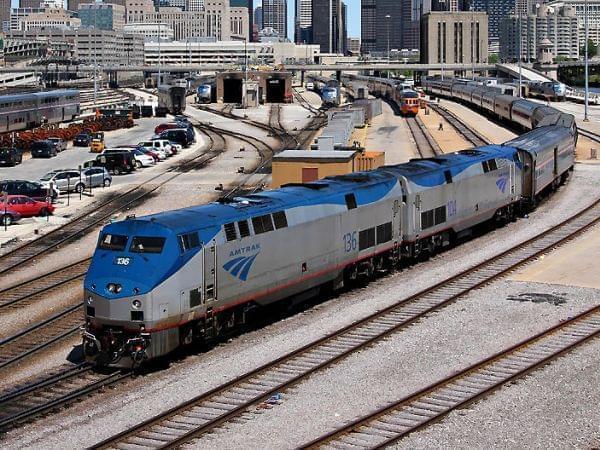What Resources Are Available For Train Staff After A Fatal Incident?

Train conductors and engineers are required to take three days off after an incident where a death occurred. Any time after that is up to the discretion of the affected conductor or engineer and a psychological counselor. Jerry Huddleston/Wikimedia
Twenty-one people died from train-related incidents in Illinois last year. That's the second most train-related deaths of any state.
The effect on victims and their families is fairly obvious. But what happens to the railroad employees when that kind of trauma occurs, and how do they cope?
It was a sunny day during one of Kathy Guy's shifts as a locomotive engineer. When she saw a man in a car coming closer to her moving train, she thought for sure he would stop. When it became apparent he wasn't going to, she applied the emergency brakes.
"Their mindset is, you're gonna stop and let them go by," Guy said. "But that's not practical; that's not the way it works."
But, Guy says, that only does so much at a moment's notice, since it takes about a mile for a train to stop. As a result, the man's car ended up going under the train wheels.
"I didn't know if he was injured, if he was killed or what," she said.
Fortunately, Guy says, the man didn't die -- he escaped the incident with only a small cut above his eyebrow.
"And he was extremely angry at me, because I didn't stop," Guy said.
Guy has not been involved in a train incident where a fatality happened in the 34 years she's worked on the railroad. She's grateful for that, because she saw what it did to her engineer father after he was involved in a fatal incident.
"My father didn't die until 1993, and even all those years later, he would still have flashbacks," Guy said. "My mom says she would wake him up in the night because he'd be, 'Stop! Stop! Don't you hear the horn?! Don't you see the train coming?!' And so it haunted him for the rest of his life."
Guy says when that happened to her father, there weren't as many mental-health resources available for him as there are for train staff today. She says conductors and engineers at that time were still expected to go to work the next day.
Today, train conductors and engineers are required to take three days off after an incident, as train staff calls it, where a death occurred. Any time after that is totally up to the discretion of the affected conductor or engineer and his or her psychological counselor.
Charles James has worked on the Union Pacific railroad for fifteen years -- fourteen of those as an engineer. He also is among those who have not experienced a death as a result of a train incident, but he knows some who have not been so lucky.
James says there are a lot of incidents that most likely were suicides; even though it still affects whomever is operating the train, there's not a lot you can do about that.
But one of James's colleagues was involved in an incident where a baby was hit by a train he was operating. It took him about six months to be able to return to work.
"You know, we have a saying on the railroad," James said. "It's kinda...[you're] more likely to come back more quicker to work if it's someone older, like a person that knows better than being on the railroad track, or a person that knows better than running around the gate, but it's much harder to come back when it's a child. A lot of people have problems with that."
James's colleague, Gordon Bowe, has worked on the rails for 39 years.
"You know, almost all of our conductors and engineers, may they be male or female, are moms and dads," Bowe said. "And they can relate having kids at home, along with the firemen and the policemen that [are] first responders. So it really brings things close to home."
Bowe says about 50 railroads pass through Illinois, which makes it a key hub for trains. It also brings a certain kind of risk.
"As we speak now, it's approximately every three hours somebody gets hit by a train, and Illinois is either the first, second or the third top for train-crossing fatalities," Bowe said.
And Bowe knows first-hand what kind of resources are available to engineers after an incident involving a death.
"Right around 18 years ago, there was a carload of kids that were teenagers and they raced us to the crossing, went around the gate, didn't make it," Bowe said. "The driver survived, the other three did not, and it really put an impact on me."
Bowe took off only the three days available to him, but that incident got him started as a volunteer for Operation Lifesaver, a group whose members visit surrounding communities to talk about train safety.
Volunteers in the program must make at least four presentations per year, but Bowe averages about 250 presentations annually. He still works for the railroad -- and he still has flashbacks of the incident, even when he’s at a school giving a presentation.
"The weight ratio between your vehicle and the train is about 4,000 to one. That's like the weight ratio between your car running over a soda can," Bowe said.
So best-case scenario, if you cross tracks in front of a train, you could end up with a $250 fine. If you do it to try to get on the train, the conductor could throw you off.
That is, Bowe says, if you actually live to tell the tale.
